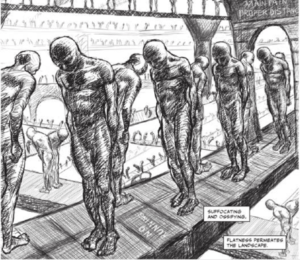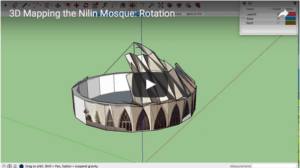PART THREE: SPATIAL HUMANITIES ON THE Z-AXIS
Week 9 – 15 (Tu 28 Mar) Center for Digital Scholarship conference room, NYUAD Library, C2, 3rd floor, room 339
Digital Humanities Meetup “What is Web Hosting, and What is it Doing in the NYUAD Classroom?”
Objective: Today’s class/meetup will review some of the reasons we have chosen a web hosting for this class. We will talk about what is different about doing one’s work in such a setting and we will look at examples of what you have done so far and have an open conversation about them.
16 (Th 30 Mar)
Today’s class is a continuation of the Dubai/UAE mapping project we began before the break. It will be a chance for each of you to pick a concrete facet of the endeavor to discuss in a three minute presentation – when written, maximum 1.5 pages doublespaced, 3 images) – Library PC cluster, room 303
Objective of today’s class: Focus in on one aspect of change or continuity, similarity or difference in the map assemblage that we have made. You can use any of the maps you like (including Google historical satellite data). Take a series of screen grabs and save them to the collective folder I shared. We will use these in class on Tuesday.
Week 10 17 (Tu 4 Apr)
Preparation for class today:
Just down some notes to the following thought questions: (What basic element of the maps have I focused on? What they have discovered, what do you not know (yet)? What do the screen grabs that you added to the folder allow you to say? What do you need to understand more about the case study to go further? Are there connections/contradictions with what Carter said about cold war mapping? Can you attribute the Soviet cartographic decisions to “dynamic of revealing and concealing”?
Discussion of results of spatial modeling: collective paper argument building in Google doc (5 minutes background of the exercise, 15 minutes of different aspects)
18 (Th 6 Apr)
Smoothing out of the different written texts in a collective redaction session.
Week 11 NYAUD DH conference
19 and 20 (10-12 April)
Blog 6 DHAD: Attend one of the panels (1.5 hours) (or hands on workshops – 3 hours) at the DHAD conference and write a blog posting describing what you learned about digital research in the humanities.
Week 12 Digital Humanities on the z-axis
21 (Tu 18 April)
Champion, “Virtual Place” Playing with the Past, 129-152.
Sousanis, “Flatness,” (chapter 1) Unflattening

from Nick Sousanis, Unflattening (2015)
Sample Projects: What Jane Saw; Virtual Monastery; Off the Map; Musée Charles X; Virtual Williamsburg; Yoruba Architecture; The Nilein Mosque; Vishnupad Temple; Digital Karnak; Rebuilding Egypt; Ancient Egypt in 3D; Altair4; UCL 3d Egypt models.
In preparation for class 22, please go to Center for Academic Technology in the library C2, 3rd floor and have them install Sketchup on your laptop.
22 (Th 20 Apr)
Building 3d content for the humanities

Explore Thingiverse, 3duniverse, Sketchup’s 3dwarehouse and Yeggi make a list of things that seem relevant to Egypt. In this session, we will attempt to build some basic 3d content and geolocate it. Before class, make an account at 3dwarehouse so that you can share your content.
der Manuelian, “Archeological Explorations” Digital Giza, 28-79 (skim)
Jaskot et al. “Visualizing the Archive: Building at Auschwitz as a Geographic Problem”
Blog posting 7 Z-axis: What did you find in the 3d repositories and sample projects with respect to ancient Egypt? Comment and suggest what other kinds of content digital humanists might build about cultural heritage. Is there an ethics to the practice of 3d modeling?
Week 13 – 23 (Tu 25 Apr)
Exploring Giza 3D and the Giza Archives
der Manuelian, “Giza 3d: The Real-Time Immersive Experience” Digital Giza, 124-153.
Kenderdine, “Embodiment, Entanglement, and Immersion in Digital Cultural Heritage” NCDH, 22-41
In-class exercise: draw by hand what you think an object from the Giza Archives would look like from multiple dimensions. What are some of the ethics and epistemological implications of immersion?
24 (Th 27 Apr)
Using Sketchup to make a 3d model of a structure from a historical site and to geo-locate it
der Manuelian, “Case Studies” Digital Giza, 154-189.
Sample project: A 3d model of the Abu Dhabi Volcano Fountain
Blog 8 Modeling ancient sites: Take screen shots and video captures of your model in Sketchup (or learn how to make a Sketchup embed from 3dwarehouse as here) and write a blog post about what you have learned from making this model, from “unflattening” objects in space. Refer to the issues (like polychrome) in the “Case Studies” to explain what options you had and what you chose to do.
Week 14 25 (Tu 2 Apr – Th 4 May) 3d printing historical objects – Center for Academic Technology
Sayers, What is Tinkering?
Other DH environments and 3d printing: Scholar’s Lab; Rutgers; Reshaping Universities; Rochester’s Minerva
Week 15 Studio – preparing final mini-projects in your web hosting
28 (Tu 9 May), (Th 11 May)
ALL WORK SHOULD BE FINISHED BY TUESDAY, 16 May at 11:59pm.
Tips for your projects:
How “finished” should my two final projects be?
The goal of project-based assessment in this course is that you bring together many of the skills and theories to which you have been exposed over the semester. If appropriate, you can cite the authors we have read as secondary material. The projects should also have some visual component (certainly illustrating the end product at whatever stage of completion it is, but also ideally illustrating steps of the projects). The projects do not need to be finished, in the sense that you have carried out all analysis possible and understood everything about them, but they should comment thoroughly on their current state of completion. Remember that one of the most important things we have learned over the semester is how thinking about knowledge creation in digital environments highlights what we do not know, just as much as what we know, and how we know. You should think about the project as you would a short paper, explaining for your readers how you got there, what you have been able to see and where you could go if there were more time.
Remember, however, that this project is a blog posting. It could be revised in the future. It is full of mash-ups, digital essai-s, an unfinished strands. They are about research, but not meant to be research papers.
Where should I publish my projects?
I suggest publishing the content of your other two projects as separate pages in your web hosting. I would also suggest giving them a succinct name, so that the tabs are clear to read. You might want to use the parent/child tab function so that you have the project tabs “stacked.” This is all your choice.
Make sure that your projects are documented, contain references to the materials you have used (in a works cited table at the end if non-electronic, and with embedded links). You can and should have some screen captures. If it is a map or 3d object, I would suggest a live embed.
How long should my project writeup be?
The project writeup should be a bit longer than a regular blog posting (1000 words maximum, I would say). I recognize fully that building a network or a map or a piece of 3d content is a time consuming process. You will be assessed based both on the quality and depth of the digital objects as well as how you write about them.
Please upload any datasets that you create (by placing them in the public_html folder of your web hosting) and provide a link for public download.
